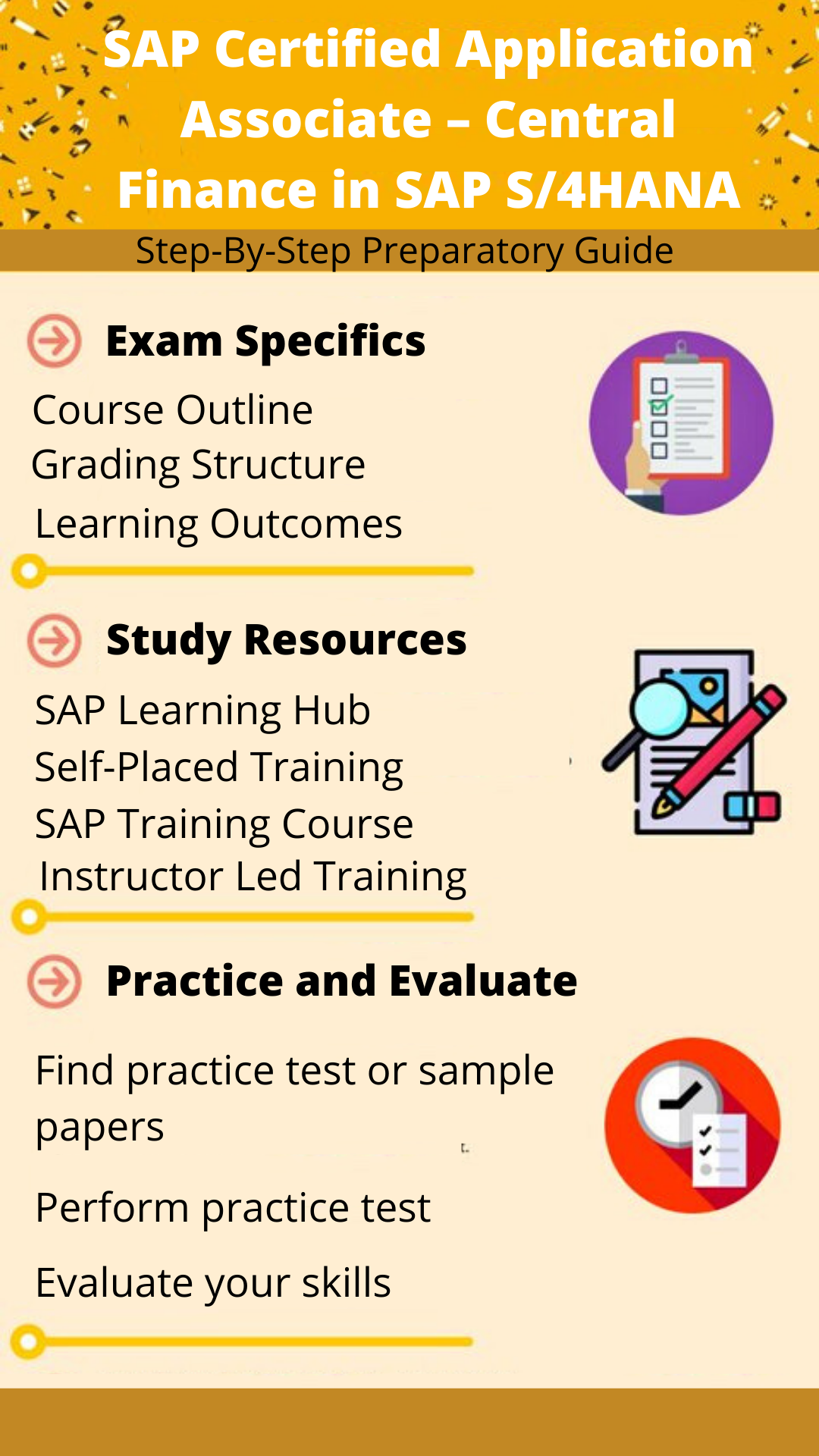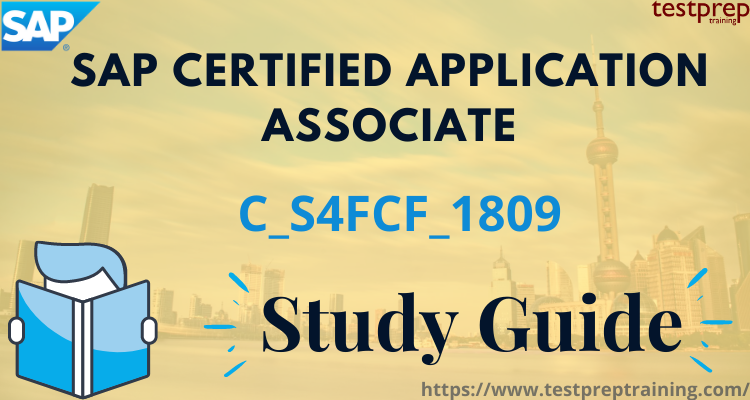C_S4FCF_1809- SAP Certified Application Associate – Central Finance in SAP S4HANA certification exam confirms that the person has the basic and essential knowledge needed for the Central Finance role. Passing this certification shows that the candidate has a good understanding and deep technical abilities to be part of a project team, often in a mentoring role.
Moreover, this exam makes your resume shine and helps you elevate your career. We know that certifications from SAP convey that you are a capable and professionally driven person but studying for them is a challenge. So here we provide you with a Study Guide and advanced Learning Resources to pass the exam with flying colors.
Who should take the C_S4FCF_1809 exam?
The SAP C_S4FCF_1809 exam is specially designed for consultants who aspire to have an entry-level qualification. It targets Software professionals and consultants to contribute to Central Finance Implementation Projects.
Learning Objectives : C_S4FCF_1809
The main objective of SAP Certified Application Associate C_S4FCF_1809 Exam are-
- Firstly, Understanding the use cases of sap central finance
- Secondly, Explaining the concept and architecture of central finance
- Thirdly, Understanding the main requirements in the sap central finance project
- Further, Providing basic knowledge on how to setting up and configuring a sap central finance landscape
- Also, Providing basic knowledge on how to execute a sap central finance project
Study Guide for SAP C_S4FCF_1809
There goes a lot of hard work and consistency in preparation for an exam. Further, it is the key to your lucrative career and opens various opportunities for you.
Achieving success in the SAP C_S4FCF_1809 exam isn’t something you can do quickly. It takes time, hard work, enthusiasm, commitment, and a willingness to learn. Our study guide will be your companion throughout this journey. If you follow it, you can pass the exam on your first try.

Step 1-Refer official site
The official site for the SAP C_S4FCF_1809 exam provides information on various technicalities and other aspects of the exam. It is the most authentic source of information and updates. Additionally, familiarizing yourself with the course is an important step for your preparations. Remember to have complete clarity about the exam course and concepts. The SAP C_S4FCF_1809 study guide covers the following domains:
1. Initial Load in Central Finance (> 12%)
Firstly, this domain focuses on describing how to set a filter for the initial load of cost object. Then, resolving errors of cost object initial load and executing initial load of fi/co postings. Also, resolving errors of fi/co posting initial load. Further, set filter for the initial load of co internal posting, and resolving errors of co internal posting initial load. Defining validation and reconciliation in central finance. Then, performing reconciliation reports in central finance.
2. Real time Replication in Central Finance (8% – 12%)
This domain aims at describing prerequisites to activate real time replication and starting real time replication. Also, correcting errors of real time replication and explaining the document flow functionality of central finance. Further it also involves performing document drill back from target system to source system.
3. System Landscape Transformation Server (SLT) (8% – 12%)
Subsequently, this domain includes concepts for describing options for activating data replication and how to transfer data, including how to change structures to source tables during replication. Also, configuring client specific and cross client replication. Then, describing starting recording and replication.
4. SAP Master Data Governance (8% – 12%)
This domain aims at building the understanding for describing mdg central governance and mass processing. Also, describing the general concepts and capabilities of sap mdg, central governance. Then, activating and configuring the default processes for mdg. defining mdg data models.
5. Central Finance Setup and Configuration (8% – 12%)
Further, this domain covers configuring the scope for the initial load of fi/co posting and defining decimal places for currencies. Also, differentiating between key mapping and value mapping. Furthermore, defining mapping actions for mapping entities, key mapping and value mappings. Configuring cost object mapping scenarios.
6. Enhancements in the Controlling Area (CO-PA, WBS) (8% – 12%)
This domain covers topics like explaining improvements made when replicating from costing-based co-pa into profitability analysis in the universal journal. Also, understanding account-based co-pa cogs split in central finance and defining account-based co-pa price split in central finance. Further, describing the new replication scenario for internal ec-pca postings, explaining the simulation tool for ec-pca and the profit center comparison report. Then, describing how wbs elements and project structures can be transferred to central finance to enable a central reporting on projects.
7. Corporate Finance Processes supported by Central Finance (8% – 12%)
This domain focuses on defining centralization of finance operations, describing intercompany reconciliation in central finance and determines open item management in central finance. Also, configuring central payments and central down payments. Further, describing ar/ap reporting in central finance, defining sap credit management and describing the integration of credit management with central finance and the relationship between credit management and central payments.
8. System Integration Concepts (< 8%)
This domain includes concepts for describing technical communications modes and processes. Also, designing the types of communication transfer modes, explaining business scenarios and the business hierarchy used by sapconfiguring rfc between two sap systems, or non-sap system.
9. Run Phase in Central Finance (< 8%)
Further, in this domain topics such as designing the sap s/4 hana central finance project phases, determining the sap s/4hana central finance pilot approach and describing the required organizational change with sap s/4hana central finance are covered. Also, determining the stakeholders involved in a central finance project, defining the change enablers and key success factors. Then, designing the operation model for central finance, and daily operations that might be needed in central finance.
10.Central Finance Landscape Architecture (< 8%)
Moreover, this domain includes defining options to sap s/4hana central finance architecture links source systems to the central finance system. Also, designing slt techchnical integration platform for central finance, describing mdg function in central finance for master harmonization and descripting aif as interface and monitoring for central finance.
11. Integration Technology ALE (< 8%)
In addition, this domain aims at differentiating application link enabling (ale) from electronic data interchange (ed). Also, defining logical system or logical system name, message type, and distribution model. Then, designing distribution model and configuring logical system names and assign them to clients in sap systems.
12. Additional Features (< 8%)
Lastly, this domain covers concepts for describing the new replication scenario for internal ec-pca postings, explaining the simulation tool for ec-pca and the profit center comparison report. Also, describing how wbs elements and project structures can be transferred to central finance to enable a central reporting on projects.
Step 2- Take a look at Study Resources
There are plenty of online and offline study resources available for the SAP C_S4FCF_1809 exam preparation. You should definitely refer all these study resources and choose the one that best suits you.
SAP Learning Hub
SAP gives candidates access to learning hubs to help them in building and maintaining their skills with:
- Firstly, self-paced digital learning content that includes e-books.
- Then, expert-led social learning forums.
- Also, access to preconfigured training systems for real-world practice.
Candidates will have access to a community of learners and self-paced e-learning courses with expert-led live sessions, and collaborative social learning rooms. Moreover, this will enhance your SAP skills as well as it will help you to connect with SAP experts. It provides access to SAP live that helps candidates to get hands-on system practice.
Self-paced Training
SAP offers self-paced training that you can do at your own speed. It’s designed to fit different learning styles and what you need to know. This training helps project team members, support professionals, regular users, and advanced users learn what they need, and you can access it from anywhere.
SAP E-Learning
SAP E-Learning means you can access specific courses online. These courses are very interactive and are available on the Internet. They allow people to get the training they need for their organizations. Students using E-learning can choose when and where they want to learn and can go over the lessons as many times as they want. Additionally, these E-learning courses include effective teaching parts and simulations that are based on real business situations.
SAP E-Academy
SAP E-Academy refers to an e-learning solution-based course that helps students to achieve expertise in specific SAP solution areas or prepare for a certification exam. However, with SAP E-Academies, you will have access to a self-paced learning environment enabling them to access:
Firstly, Online Learning Content
In this the content is delivered to candidates in an e-learning format consisting of presentation slides with audio commentary, system demonstration/practice simulations, slide notes, and mentor tips. This also provides a brief about the SAP C_S4FCF_1809 syllabus and guide.
Secondly, SAP Training Systems
With this the student can use the live training systems hands-on to test their own business process scenarios, complete exercises from their student manual and view demonstrations.
Also, Help Desk Support
SAP offers help desk support while you’re learning, and they respond to any questions within 24 hours from Monday to Friday. They also provide technical support for the special features of your learning environment.
Instructor Led Training
SAP provides Instructor-led training where you learn from an expert, and the other training it offers is virtual live classroom (VLC) training, which is like live training but online, so you don’t have to travel. They also have training customized for your company, where you still get expert live training from SAP, but it’s designed specifically for your organization.
SAP Training Course
To increase your chances of success, SAP suggests taking training courses to prepare for the exam. These courses are designed to make sure you have a solid grasp of SAP exams, even starting from the basics. SAP’s Training courses help you use the knowledge you’ve learned in training effectively. You can find online training courses for each part of the exam on the official SAP website.
Step 3- Practice Test
The evolution of practice tests from pen-paper to online mode has done nothing but added more efficiency to the exam preparation process. The use of SAP C_S4FCF_1809 practice exam tests helps the potential aspirants to sail through the exam with complete ease. The reason being, candidates are already aware of the exam environment. Also, they have a cue regarding questions that will appear in the actual scheduled exams. Moreover, attempting multiple practice tests is vital for boosting confidence. Lets Self Evaluate our performance with Practice Tests!



